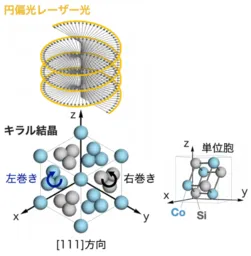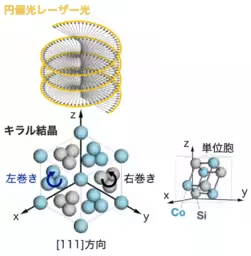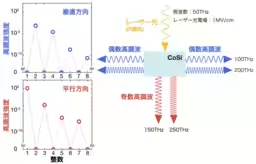

Revolutionary Prediction of Optical Current Generation in Chiral Materials
Overview
Recent advancements in laser technology have significantly improved our understanding of how laser light can manipulate electrons within materials, thereby revealing new properties and functions. A team from Waseda University, led by Yuya Ominato and Masahito Mochizuki, has made a groundbreaking theoretical prediction regarding the generation of directional electric currents when laser light is directed at a compound made of cobalt and silicon, known as CoSi. This exploration of chiral materials may bring forth a host of innovative light electronics capabilities.
Discovery Details
In their research, the scientists discovered that when laser light illuminates materials with chiral crystal structures, it not only generates a directional electric current but also produces light with frequencies that are integer multiples of the illuminating laser beam. These findings indicate a wide range of potential applications such as current generation, switching on and off currents, and converting light signals into electrical signals, thus marking a promising future for light-driven electronics.
The Significance of Chirality
Chiral structures are characterized by their lack of symmetry, much like left and right hands that cannot be superimposed. The CoSi compound possesses a unique chiral crystal structure that can be observed from its [111] crystallographic direction, revealing a spiral arrangement of its atoms—cobalt and silicon adopt opposite spiral conformations. The researchers propose that illuminating such materials with light could evoke responses that depend on the relative alignments of both the crystal and the light's direction.
This innovative approach could enable the manipulation of electronic properties using light—an avenue that presents many scientific and technological challenges, but one that is rapidly evolving due to advancements in laser technology.
Mechanisms of Current Generation
The study theorizes two major phenomena:
1. Controlled Optical Current Generation: By adjusting the intensity and frequency of the laser light, researchers found that they could switch the direction of the electric current generated in CoSi. The study highlighted how the orientation of the current would reverse depending on whether left or right circularly polarized light was used.
2. Generation of High Harmonics: They also identified that light emanating from the CoSi material exhibits frequencies that are integer multiples of the illuminating light's frequency, revealing an intriguing new phenomenon called high harmonic generation. This opens up the possibility of developing devices that capitalize on light’s frequency and propagation direction for enhanced functionality.
The findings suggest that chiral materials hold significant promise in the ongoing progression of optical electronics, particularly through novel phenomena that could enable light-based devices with superior efficiency.
Implications and Future Directions
The implications of this research extend beyond fundamental science into technology, spanning multiple fields such as materials science, photonics, and electronics. With this theoretical foundation laid, it is anticipated that experimental validation will follow, fostering further investigations into similar chiral materials like MnSi or FeGe.
By leveraging the unique properties of chiral crystals, new electronic devices could emerge, enabling innovations in energy conversion and information processing. These advancements may result in the development of low-power, high-efficiency optical devices such as optical switches and rectifiers, paving the way for the next generation of light electronics.
The Research Process
The researchers utilized a theoretical approach known as Floquet theory, which describes systems driven by periodic external fields, to explore how electron movement could be expressed in relation to laser light's characteristics. The output from their computational modeling suggests that one could manipulate charge carriers' directions with remarkable precision using laser beams, effectively unlocking new functionalities in the realm of electronics.
Conclusions
In conclusion, this research introduces a fresh perspective on the potential of chiral materials in light electronics by uncovering how laser illumination can yield new phenomena that may redefine electronic components' capabilities. Further studies will not only assist in confirming these theoretical predictions but will also enhance our understanding of these chiral systems, leading to groundbreaking applications.
This research appears promising for a future where light manipulation in materials could revolutionize technology across numerous fields. The next steps will involve actualizing theoretical predictions into experimental setups, a goal that the research team is eager to pursue.



Topics Consumer Technology)










【About Using Articles】
You can freely use the title and article content by linking to the page where the article is posted.
※ Images cannot be used.
【About Links】
Links are free to use.